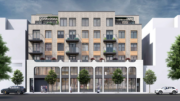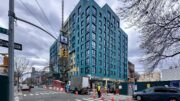The official Census guesswork for 2017 has now been released, showing a gain of 7,272 individuals across the Five Boroughs, and a drop of over 2,000 people in Brooklyn. While the actual Census in 2010 was decried as leaving hundreds of thousands of New Yorkers missing from the count, it seems that whoever was behind the calculations for 2017 may have been even more incompetent, with changes to the borough-by-borough tallies painting a picture that makes no sense whatsoever.
While a small overall increase in the city’s overall population is potentially believable, the distribution of gains and losses is what illuminates glaring inaccuracies in yesterday’s data release.
Though Brooklyn has been in the midst of a development boom since the early 2010s, with tens of thousands of new units entering the borough’s pipeline since the start of the decade, the borough somehow registered a year-over-year population decrease. With the wave of new openings set to crest this year or next, it seems highly unlikely that the deluge of supply would result in a drop in the borough’s population.

The bogus Brooklyn numbers beg the question of why any of the other estimates should be given credence. In this instance, they probably shouldn’t have any credibility whatsoever, considering that the esimated gains across the rest of the city were also barely noticeable. Queens and The Bronx supposedly added fewer than 5,000 residents combined, again, a figure falling far short of the new inventory of total units coming online between both boroughs last year.
While the Census estimates for the aforementioned boroughs appear woefully inaccurate, the numbers for Staten Island and Manhattan are somewhat more plausible, with gains of approximately 2,500 and 2,000 residents apiece, respectively.
Though quibbles regarding data points may seem trivial, come 2020, the next Census will be a critical tool for ensuring New Yorkers are properly represented at the Federal level.
Woeful undercounting was a major problem back in 2010, and was partially to blame for the seemingly-dramatic increase in the city’s population numbers at the start of the current decade. The most recent estimates could hint that results come 2020 could be even more unrepresentative of the actual truth.
Unfortunately, it would appear that this impending problem is probably without a solution, as this year’s data release is clearly more inaccurate than anything since the last actual Census, in 2010.
Subscribe to YIMBY’s daily e-mail
Follow YIMBYgram for real-time photo updates
Like YIMBY on Facebook
Follow YIMBY’s Twitter for the latest in YIMBYnews






trump’s threats against immigrants – legal as well as illegal – guarantees massive undercounts of residents of all major American cities.
This is a feature, not a bug.
Wait, you mean that people who aren’t supposed to be living in this country won’t want anyone to know that they are living here? This is somehow intolerable to you?
The American citizens who employ them also prefer no one knows.
The idea that Brooklyn has seen an exodus of upwards of 2,000 residents is very valid. It’s been already reported in the Wall Street Journal that the overly-ambitious development in Brooklyn has resulted in landlords offering “incentives” to present residents of their buildings, such as a rent-free month or two, to keep them there, with mixed results.
In another published report, some parents of young children are not too happy with some recent changes made by the Dept. of Education of closing some schools and transferring students to what the article called, “less desirable” schools.
Additionally, the once-heralded “hipster” movement have determined that, now, Brooklyn is too rich for their blood.
There may be more to the exodus yet to come.
Incentives are standard practice in NYC real estate, and if they were an indicator of falling population, Manhattan would’ve been at 0 long ago. The Census has had major historic issues in counting the Boroughs properly, if they could at least incorporate some aspect of construction filings in constructing their data the numbers would not be so unrealistic.
Biased, much? As the first comment pointed out, undocumented immigrants are too afraid to be counted. Then there are all those hipsters living (illegally) 6 to a room. That could easily add up to 2000.
@ Paul –
So when cities were claiming undercounts back in 2010, could we also blame Obama?
@antinimby:
Sorry, but what part of this phrase in the article:
“While the actual Census in 2010 was decried as leaving hundreds of thousands of New Yorkers missing from the count, it seems that whoever was behind the calculations for 2017 may have been even more incompetent,…”
did I miss?
The bottom line is that whatever shortcomings the census had as of 2010 will be exacerbated by the efforts of the trump administration to turn millions into “nonpersons” afraid to deal with the government.
Where are you getting your data ? The census shows that there was a gain of 400,000+ in NYC between 2010 and 2017. Where are you finding 7,000 ?
Click into the tables and you can see the update at link:
http://www1.nyc.gov/site/planning/data-maps/nyc-population/current-future-populations.page#collapse3
The growth from 2016-2017 was 7,000. The growth from 2010-2017 is approx.78,000.
The census has been poorly conducted for several decades. With a much more competent administration in office that understands the actual utility of an accurate census I fully expect 2020 to be a much better performance. The idea that people with accents are “afraid” to answer the census is absurd racism from the left. A failure to understand the civic purpose of a census is all that is at issue here. Do we want to know how many people live in our country or not That’s the only question – accomplishing the task is not even remotely out of our competency.
Remember Manhattan’s peak population was 2.3 million in 1910. Today it is 1.6 million. Its about cost. There will always be less rich people than poor.In this context the numbers do make sense. The residential units being built in Brooklyn are generally luxury. The people leaving are low to middle income. Brooklyn is getting too expensive for most working people and it will just be Manhattan 2.0.
culprit and Paul 52: so which one is it? “immigrants are too afraid to be counted” or “thanks to Trump there is a massive exodus of immigrants from New York”? Biased much isn’t it? If “they” are too afraid to be counted, Do you that phenomenon just started a year ago – I assume the census ran in 2016 before the election and the crackdown on mothers and fathers of american kids (much easier to pick them up at school than run after criminals…but I digress) – Do you really think that before that time illegal immigrants under Reagan, Busch, etc…were not scared and were not hiding from census. Is that really what you believe? Let’s agree that it is not a valid argument and explanation for a decrease as it is has been a constant through every single census. Mathematically your analysis is wrong. You can praise your leader maximus all you want, thats ok we are all fan of something, but for your sanity add a bit of critical thinking, it goes a long way. And yes I put the country where I am born in my pseudo so you can have fun as well!
It is a problem that city planning goes with estimates, as it will impact infrastructures decisions. Basically they say that we added almost half a million people in 6 years (for which we didn’t do too much in infrastructures improvements since it takes 20 years to get there. Then they see a pattern the last year that is showing a slow down or a decrease. Which in the mind of fiscal conservatives and cautious spenders will translate in “we don’t need more infrastructures as the population decreases”. And we get to keep old tunnels, bad streets, public schools, libraries etc….
You are right it is stupid.
When a family living in an overcrowded apartment is forced to move to Charlotte or Atlanta and replaced by one rich yuppie, population declines.
If you want a real determination of the population…and the fiscal state of NYC…get the numbers for welfare and Medicaid recipients.
When Mike Bloomberg was getting ready to leave office, City Hall announced, with great glee, an increase in NYC’s population (the number of which escapes me). When asked by an intrepid reporter what jobs or occupations this new population was gravitating to, the reporter was given short-shrift over several inquiries, and given no answer. Eventually, the reporter got her answer: “No Comment.”
That statistic what people are going to what jobs use to be a standard number out of City Hall, now it gets “No Comment.”
I’m sure an inquire to a deBlasio City Hall would get the same reply today.
Read today’s NYT..much different story
That’s because the numbers they used are completely made up. The Census plays with the data every year… the actual result vs. what 2016 supposedly was, is, in fact, an increase of only 7,272.
NYC population density 2017:
Borough || 2017 pop || Sq Mi || avg pop per sq mi 2017 || as % nyc pop density
Bronx || 1,471,160 || 42.10 || 34944 || 122.7%
Brooklyn || 2,648,771 || 70.82 || 37401 || 131.3%
Manhattan || 1,664,727 || 22.83 || 72918 || 255.9%
Queens || 2,358,582 || 108.53 || 21732 || 76.3%
Staten Island || 479,458 || 58.37 || 8214 || 28.8%
NYC || 8,622,698 || 302.65 || 28491 || 100.0%
The data shows a net gain of 144,000 people from 2010 to 2017. Focusing a the one year change seems much less important. There could be idiosyncratic factors that may have led to a year drop (a blip), but the more important number is what is happening in the long run. Since 2010 Brooklyn is the Borough that has gained the most people: that’s the key showing of the census. Therefore decrying it as woefully inaccurate because of a one year (minor) drop seems like an effort to make a mountain out of molehill. Who knows? There could be strange reasons why population could have dropped slightly in the one-year period. For example, while many people are moving in, many former 10-room SROs are being converted into one family houses in some areas. Every one buyer moving in, paying $3 million for a townhouse is equaled by 10 families moving out of the city altogether.
Frequent stories in the press about wealthy people buying a multi-family building and converting it to a 1-family dwelling. An expensive but legal process. I don’t know how prevalent it is. A few 2-family homes in my neighborhood have been legally converted to 1-family homes. The new buyer may have a large family or just wants more space. A friend’s daughter bought a ramshackle 3-family house up in St. George and legally converted it to a 2-family house. The NYCDOB gave her grief but approved the plans.